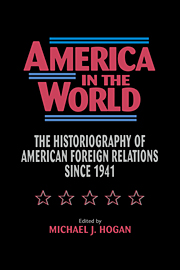Book contents
- Frontmatter
- Contents
- Preface
- The Authors
- Part One The State of the Art
- 1 State of the Art: An Introduction
- 2 “Revising Postrevisionism,” Or, The Poverty of Theory in Diplomatic History
- 3 New Approaches, Old Interpretations, and Prospective Reconfigurations
- 4 The Long Crisis in U.S. Diplomatic History: Coming to Closure
- 5 Commentaries
- Part Two The Historiography of American Foreign Relations since 1941
- Index
1 - State of the Art: An Introduction
Published online by Cambridge University Press: 05 June 2012
- Frontmatter
- Contents
- Preface
- The Authors
- Part One The State of the Art
- 1 State of the Art: An Introduction
- 2 “Revising Postrevisionism,” Or, The Poverty of Theory in Diplomatic History
- 3 New Approaches, Old Interpretations, and Prospective Reconfigurations
- 4 The Long Crisis in U.S. Diplomatic History: Coming to Closure
- 5 Commentaries
- Part Two The Historiography of American Foreign Relations since 1941
- Index
Summary
The last half-dozen years have seen the publication of several major essays on the state of American diplomatic history. These include widely read articles by John Lewis Gaddis, Bruce Cumings, Melvyn P. Leffler, and Michael H. Hunt. Gaddis is a leading post-revisionist scholar in the field and has a large following among political scientists who specialize in international relations. Cumings blends the assets of an East Asian specialist with insights into American politics and foreign policy. Leffler is associated with those historians who focus on American national security and geostrategy. Hunt is an area specialist whose work has dealt with Sino-American relations as well as the role of ideology in American foreign policy.
This introduction reviews the state of diplomatic history by evaluating what these four historians have said on the same subject. Three of them, Cumings, Leffler, and Hunt, outline their own thinking in the essays that follow and have contributed commentaries that critique each other's work and react to the views expressed in this introduction. The fourth, John Lewis Gaddis, spelled out his thinking in a controversial address to the Society for Historians of American Foreign Relations. His views are evaluated below and are also taken up in the essay by Cumings and in the commentaries by the three contributors to this section of the volume. All of these scholars have different agendas. Each assesses the field, or at least some of the key works and major schools of thought, and each urges us to take diplomatic history in a certain direction.
- Type
- Chapter
- Information
- America in the WorldThe Historiography of US Foreign Relations since 1941, pp. 3 - 19Publisher: Cambridge University PressPrint publication year: 1996



